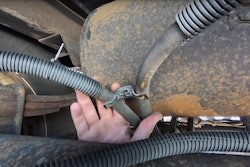Trucking news and briefs for Tuesday, Nov. 15, 2022:
TWIC, hazmat endorsement fees get more affordable
The Transportation Security Administration announced recently it is reducing the fees associated with obtaining a Transportation Worker Identification Credential (TWIC) and a Hazardous Materials Endorsement (HME). The new lower fees took effect Nov. 3.
TSA conducts security threat assessments (STAs) of applicants to these programs and collects fees from the applicants to recover its costs to conduct the vetting and credentialing. The administration said fees are impacted by several factors, such as changes in contractual services. TSA reviews its fees every two years, and upon review, if it finds that the fees collected exceed the total cost to provide the services, or do not cover the total cost for services, it must adjust the fee.
Prior to Nov. 3, the application and renewal fee for the TWIC Program was $125.25, while the reduced application fee for applicants who possess a comparable STA, such as an HME, was $105.25. The replacement card fee for lost, stolen, or damaged TWICs was $60.00.
In August, TSA implemented a new online renewal process for certain TWIC applicants, allowing permits-eligible applicants to renew their TWIC without visiting a TSA enrollment center. Online renewal will now cost $117.25, with in-person renewals or new applications remaining at $125.25.
The revised fee for an eligible reduced-fee enrollment decreased from $105.25 to $93, and the fee for a replacement card is the same at $60.
For the hazmat endorsement, the fees will remain the same for new enrollments and renewals. However, TSA is revising the fees that apply when using a comparable threat-assessment to obtain an HME. The fees for applicants with a comparable assessment was reduced from $67 to $41.
J.B. Hunt sets ambitious emissions reduction goal
J.B. Hunt Transport Services (CCJ Top 250, No. 3) has announced a new goal to reduce its carbon emission intensity 32% by 2034 (baseline 2019), advancing the company’s sustainability vision of moving the freight industry towards a low-carbon future.
“Our roadmap to achieving this aspirational goal will help J.B. Hunt strive to significantly reduce our carbon emission intensity while holding true to our customer commitment of providing efficient, quality-driven, competitive supply chain solutions for moving their freight,” said Craig Harper, chief sustainability officer and executive vice president at J.B. Hunt. “Our goal is an ambitious challenge to improve J.B. Hunt’s carbon footprint and to help advance the transportation industry’s progress in developing sustainable solutions that are commercially viable and scalable for widespread adoption.”
Specifically, J.B. Hunt will focus on three key areas to reach its emission-reduction target by 2034:
- Incorporating alternative-powered equipment into its fleet
- Expanding the use of biogenic fuels
- Improving fuel economy
Achieving the company’s ambitious target is dependent on significant progress with the development and availability of new industry technology and the infrastructure needed to enable their day-to-day use on an industry-wide scale, the company said.
Examples include developments such as: ongoing enhancements to commercial motor vehicles; charging and refueling infrastructure; expanded capacity on the electrical grid; increased availability of biogenic fuels and the incorporation of more energy resources with lower carbon intensity.













